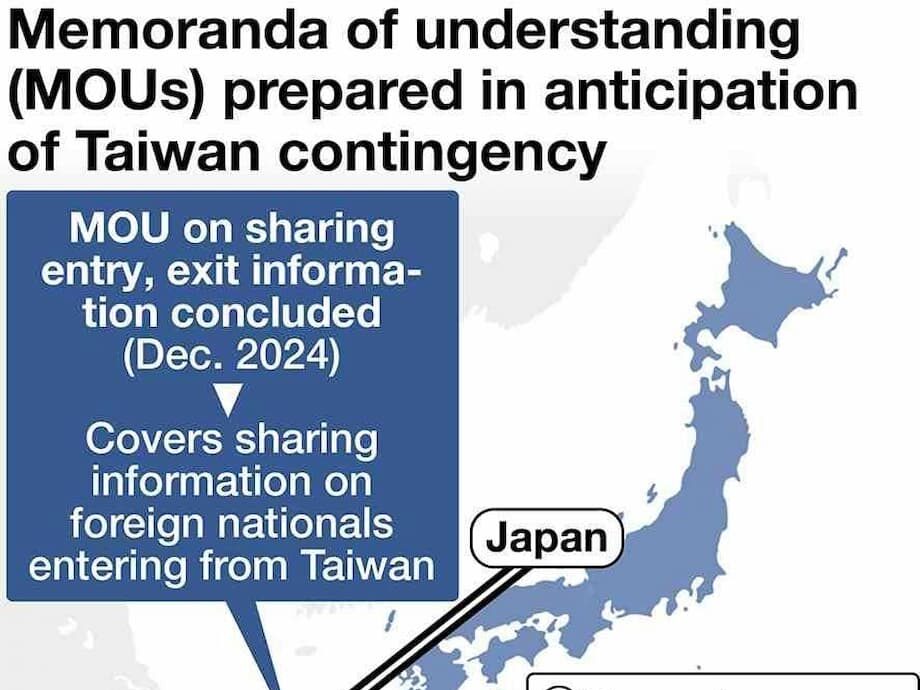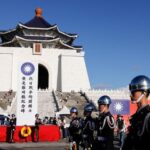Why a quiet immigration pact signals serious contingency planning
Japan and Taiwan have taken a rare step to coordinate civilian movements in a crisis, signing a memorandum that allows Japan to receive information about foreign nationals seeking entry from Taiwan if a Taiwan emergency erupts. The accord, formally titled a memorandum of cooperation on sharing information regarding matters related to immigration control, was signed on December 18 by the Japan Taiwan Exchange Association and the Taiwan Japan Relations Association. The content remains confidential, yet multiple Japanese sources say the goal is clear, to prevent spies and violent actors from slipping into Japan during any large scale evacuation while helping genuine evacuees move safely and in an orderly way.
- Why a quiet immigration pact signals serious contingency planning
- What the memorandum covers
- Why Tokyo worries about infiltration during evacuations
- Inside Japan’s own evacuation planning near Taiwan
- Allies and partners prepare for a Taiwan emergency
- What travelers can expect if a crisis unfolds
- How Beijing may view the move
- Legal and diplomatic constraints behind the scenes
- At the heart of the issue, civilian safety
- The Bottom Line
The arrangement is striking because Japan and Taiwan have no formal diplomatic ties. Tokyo recognized Beijing in 1972, so its Taipei facing institution is a private association that functions as a de facto embassy. Using these channels, both sides can share essential border control information without changing their political positions. The agreement also sets up checks before departure at Taiwanese airports for travelers bound for Japan even in normal times, a move meant to strengthen screening, reduce congestion at arrival gates, and build habits that can scale under stress.
The timing reflects concern about rising pressure on Taiwan. China has increased air and sea activities around the island and expanded military drills that simulate blockades. Some analysts in Japan say Beijing could be prepared for an attack as early as 2027. As of October 2024, about 21,700 Japanese nationals were living in Taiwan, according to Japan’s Foreign Ministry. In a crisis, many of those residents would seek to return, and large numbers of Taiwanese and other foreign nationals could try to evacuate across the East China Sea. Japanese planners want order, not chaos, at their borders if that day comes.
What the memorandum covers
While the two associations have not disclosed the text, official briefings and media reporting sketch the essentials. Japanese authorities would receive information from Taiwan to screen foreign nationals coming to Japan in a crisis, allowing security services to flag high risk individuals before they arrive. The mechanism is designed to cut the risk of infiltration by agents or violent groups during an evacuation while allowing most evacuees to move swiftly. Importantly, similar checks would run during regular times for flights from Taiwan to Japan. That builds a common procedure that both sides can scale in an emergency.
How screening would work
Screening in this context typically means cross checking passenger data with watchlists and immigration records, verifying identities, and validating travel documents before departure. It can include enhanced questioning and secondary inspection for people who trigger specific flags. By moving much of the review to the point of embarkation, Japan aims to reduce bottlenecks at busy arrival halls inside the country if carriers rapidly increase flights or ferries during a crisis.
What changes in peacetime
Outside emergencies, travelers departing Taiwan for Japan would face a light check that is intended to be unobtrusive. The associations have not released specifics, a common practice for security programs that rely on some degree of secrecy to remain effective. Based on comparable arrangements, the focus would likely be on identity verification, document validation, and advance passenger information transfer to help authorities spot anomalies with minimal impact on most passengers.
Why Tokyo worries about infiltration during evacuations
Evacuations are complex and can be disorderly. Intelligence services and violent actors have exploited large movements of people in past conflicts by blending into vulnerable crowds. Japanese officials worry that a Taiwan emergency could see an influx of foreign nationals who need help alongside a small number of people intent on causing harm. The memorandum is meant to reduce that risk while preserving humanitarian pathways for those who need them.
A Japanese government source, cited by The Japan News, framed the infiltration risk in stark terms before the agreement surfaced publicly.
Chinese agents could enter Japan by concealing themselves among Taiwanese nationals.
Japan’s Immigration Services Agency maintains technical memorandums with close partners such as Australia and New Zealand for issues like overstayers. The new Taiwan focused memorandum is different. It assumes a sudden wave of evacuees that includes Japanese nationals, Taiwanese residents, and other foreign nationals, and it equips Japanese authorities with information flows to separate high risk targets from people simply seeking safety.
Inside Japan’s own evacuation planning near Taiwan
Tokyo has also begun planning for its most exposed citizens on islands close to Taiwan. Japan announced a plan to evacuate about 120,000 people from the Sakishima island group in Okinawa Prefecture if armed attacks are predicted. The plan would move roughly 110,000 residents and 10,000 visitors off Ishigaki, Miyako, Taketomi, Yonaguni, and Tarama within six days using planes and ferries. Evacuees would first head to Kyushu, including Fukuoka and Kagoshima airports, and by sea to Yamaguchi and other points, then disperse to designated accommodations in eight prefectures in southwestern and western Japan.
Japanese media have reported parallel steps to harden local defenses. Yonaguni, only about 100 kilometers from Taiwan, has a Self Defense Forces base and is building temporary underground shelters stocked with food and water. The government has also discussed new missile deployments across the southwest. Okinawa hosts a large United States military presence, almost 50,000 troops, which would become central to logistics and deterrence in a Taiwan emergency.
Chief Cabinet Secretary Yoshimasa Hayashi has portrayed the evacuation outline as a practical step to deepen discussions about moving residents safely if danger escalates. As Kyodo News reported, Hayashi said the government drew up the plan with a clear scenario in mind.
on the assumption [Japan will encounter] a situation where armed attacks are predicted
Drills in Okinawa are slated for fiscal 2026. The government says it will plan for a range of needs, from quick transfers for healthy residents to long term support if evacuations last longer than a month, including food, medical care, and accessible transport for people with special needs.
Allies and partners prepare for a Taiwan emergency
Japan is aligning its crisis playbook with allies. Tokyo and Canberra plan to sign a memorandum that would allow the two countries to accept each other’s citizens during evacuations from third countries, share information in emergencies, and coordinate plans during regular times. Australia would be the second partner after South Korea to agree to such cooperation. Under the approach, each side could fill empty seats on chartered aircraft or buses with the other’s citizens so scarce lift is not wasted.
Regional governments and experts are also exploring how to move large numbers of people if air and sea routes close. A two day war game in Singapore brought together officials and security scholars to simulate a blockade around Taiwan. Participants concluded that Southeast Asian countries would likely lean on a Singapore led airlift to evacuate up to one million of their nationals in a crisis. The exercise underscored the scale of logistics that could be required and the value of pre arranged corridors that rely on coordination with the United States, Japan, and China.
What travelers can expect if a crisis unfolds
For people flying from Taiwan to Japan during a crisis, the most visible change would be checks before departure at Taiwanese airports. That could include additional identity verification, document scans, and questions for some passengers. The goal is to reduce stress on arrival terminals and speed entry for the vast majority of evacuees while directing higher risk cases into secondary screening.
In regular times, the checks that flow from this memorandum are expected to be light and targeted. The associations declined to release operational details, which is common for border security programs. Japanese law provides a framework for protecting personal information in government hands, and immigration authorities routinely handle sensitive data under statutory limits. Balancing security and privacy will remain a central concern as procedures roll out.
How Beijing may view the move
China’s military has normalized more frequent air and sea activity around Taiwan. Large drills in recent years have practiced blockade, encirclement, and missile strike scenarios. This pattern has drawn worry in Tokyo and Washington. Think tank reporting in early 2025 noted that Beijing criticized parts of Japan’s evacuation planning for its southern islands, a sign that even civilian focused preparations can become politically charged in the region’s tense atmosphere.
Japanese officials have been careful to cast the Taiwan related memorandum as a safety and border control tool. The pact does not alter Japan’s official position on Taiwan’s status. It aims to stop bad actors from exploiting evacuation flows while smoothing the way for civilians who need to move. That message is likely intended for two audiences, a domestic public that expects the government to plan for worst case scenarios, and foreign governments that watch any change in cross strait posture for signs of escalation.
Legal and diplomatic constraints behind the scenes
Because Japan cut formal ties with Taiwan in 1972, all cooperation runs through representative bodies rather than embassies and ministries. The Japan Taiwan Exchange Association serves as Japan’s window for everyday diplomacy in Taipei, and the Taiwan Japan Relations Association acts as its counterpart. Agreements between these organizations have the backing of government policy without breaking with the one China framework that Tokyo has maintained for decades.
Japan has used technical memorandums to address immigration control topics with partners such as Australia and New Zealand. Those texts often focus on overstayers and document fraud. A memorandum designed with a potential mass evacuation in mind is unusual. It reflects a judgment in Tokyo that the region’s security climate calls for practical steps now, so that bureaucracies and carriers can move faster if the crisis everyone hopes to avoid ever materializes.
At the heart of the issue, civilian safety
Any Taiwan emergency would be first and foremost a human story. Japan tracks more than twenty thousand of its citizens living on the island. Large numbers of Taiwanese and other foreign nationals would likely seek temporary refuge in Japan if fighting or a blockade made staying impossible. Airports and seaports would need to scale fast, which is why authorities are rehearsing routes from Okinawa’s outlying islands to Kyushu and beyond, and why they are setting expectations for checks before departure on Taiwan bound flights to Japan.
Cooperation with the United States, Australia, South Korea, and Southeast Asian partners would matter because air and sea corridors depend on regional consent and capacity. A Singapore led evacuation for Southeast Asian citizens featured in the simulation exercise precisely because coordination will be essential. Japan’s new memorandum with Taiwan is one piece of that wider puzzle, an attempt to separate the very small number of bad actors from the very large number of people who might need safe passage. The more of that sorting that happens before airplanes push back or ferries cast off, the less pressure there will be at Japanese arrival points when time is tight.
The Bottom Line
- Japan and Taiwan signed a confidential immigration control memorandum on December 18 that enables advance screening of foreign nationals coming to Japan from Taiwan in a crisis.
- The accord also provides for checks before departure at Taiwanese airports for Japan bound travelers during regular times.
- The aim is to prevent infiltration by spies or violent actors during any large scale evacuation while keeping evacuation routes open for civilians.
- About 21,700 Japanese nationals lived in Taiwan as of October 2024, highlighting the scale of potential evacuations.
- Japan has unveiled plans to evacuate about 120,000 people from Okinawa’s Sakishima islands within six days if armed attacks are predicted, with drills planned for fiscal 2026.
- Chief Cabinet Secretary Yoshimasa Hayashi said the island evacuation plan was drawn up on the assumption that armed attacks could be predicted.
- Tokyo is aligning with allies, planning a new evacuation cooperation memorandum with Australia and relying on existing ties with South Korea and the United States.
- China continues frequent drills around Taiwan, and analysts say its preparations have intensified, increasing urgency in Tokyo’s planning.




